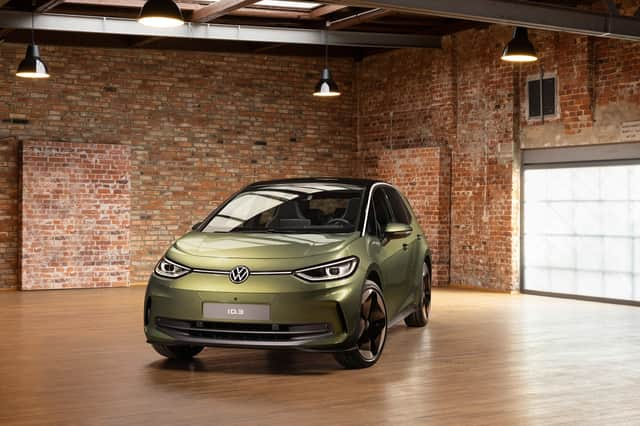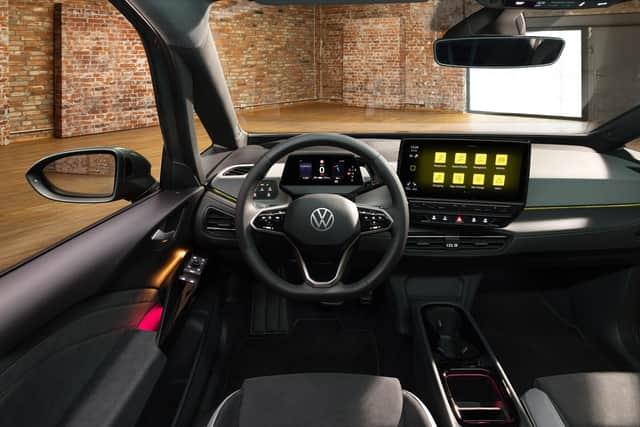Volkswagen ID.3 facelift answers customer complaints with interior and infotainment upgrades


It may still be less than three years since Volkswagen launched the start of its new all-electri future by introducing the ID.3, but already it has unveiled what is, essentially, the second generation of the German marque’s electric Golf-sized family hatchback.
The latest, chunkier ID.3, which will go on sale in the UK in late spring with prices expected to start around £41,000 is, by VW’s own admission, very much a result of having listened “very carefully” to the ID.3 community. That community is significant: VW claims 300,000 ID.3s have been sold since deliveries started during the third quarter of 2020.
Advertisement
Hide AdAdvertisement
Hide AdInitially this facelift wasn’t scheduled by VW until 2024, but such was the reaction — almost immediately from launch — to the EV’s software and interior quality that the company fast-tracked the new improvements. And so extensive are the upgrades that even VW now refers to it as the “second generation” ID.3.
One of the main areas of criticism when the ID.3 was its digital and driver interfaces. No surprise then that VW has made improvements in the field. First, what hasn’t changed is the digital instrument panel, which is still 5.3-inches across, and the rocker switch at the side of the steering wheel for gear selection remains in place. There are, however, changes to the infotainment setup, but they are not as widespread and comprehensive as many would have wished. At least not on this occasion. Further IT upgrades will arrive in 2024 simply because while VW could bring the core facelift forward by 12 months or so, the techie stuff is on a fixed deadline and isn’t available till next year.
Anyway: back to this facelift. While mainland European markets will get a new 12-inch central display as standard, UK buyers will be restricted to a 10-inch screen for the time being because the layout of the dashboard has not yet been changed for right-hand drive. In addition, there are only relatively minor changes to the interface. These see the charging controls, which were previously based on a sub-menu, now moved to the top level of the home screen. “Feature on demand” technology will now also be supported, meaning users can access increased functionality for as short a period as one month. Worth highlighting that since the ID.3 models coming to the UK already benefit from features such as navigation and dual-zone climate control, the only potential add-on we’re likely to benefit from is an upgrade from 10 ambient-light colours to 30.
One interesting and potentially important upgrade is in VW’s own navigation software which now allows the route planner to schedule charging stops more effectively on longer journeys. It may well suggest that rather than have one stop at a lower-powered plug, it will identify two short stops at points with faster charging capability. The infotainment system also supports Apple CarPlay and Android Auto.
Advertisement
Hide AdAdvertisement
Hide AdBut there are already further additional changes and improvements scheduled. VW says a different 12.9-inch display will become standard in the ID.3 (including in the UK) from the middle of next year. This will incorporate what many people have been crying out for; backlighting to finally illuminate the combined slider control for the heating and audio volume. Thank goodness because currently you can’t see them in the dark.


Elsewhere inside the car VW emphasises it has listened to customer feedback and made the corresponding positive changes. In addition to new ambient lighting, there are now more areas in the passenger cabin which have been padded with foam. A direct result of customers who criticised the ID.3 as not being as plush as a Golf. That would also account for the redesign of the door inlays which now include softer, larger surfaces. Look closely and you’ll also spot new double-stitching on the fabrics and padded areas on the main fascia.
The use of sustainable materials has also been improved and increased. Not only are the second-gen ID.3’s fabrics all completely animal free, but the microfibre material used on the door trims and seat covers — VW has named it Artvelours Eco — is made from 71% recycled plastics.
As you would expect of a design which is now labelled “second generation”, there are some notable and significant changes in the external styling of the ID.3, all aimed at setting it apart from the original. Designers have given the front bumper a sharper, stronger look, while models fitted with Matrix-LED headlights now get an animation which welcomes and says goodbye to the user as they approach and leave the vehicle.
Advertisement
Hide AdAdvertisement
Hide AdLook carefully at the base of the windscreen and you’ll spot that the black plastic area which appeared at the base of the first-gen ID.3 has disappeared, replaced by a larger body-coloured bonnet. I must admit, it’s a change I welcome. VW says it’s intended to “create an additional impression of visual lengthening”. It also has resulted in a slightly improved drag coefficient.
There’s also a new palette of external colours — including the Dark Olivine Green in our images — plus headlights and tail-light clusters. While the former includes distinctive X-shaped daytime-running lights, the latter incorporates refreshed scrolling indicators.
VW has also streamlined the trim level range, with only the Pro and Pro S specifications to be offered.
While there are new looks and tehcnology, the battery and motor setup remains essentially unchanged. Buyers get capacity choices of 58kWh in the Pro and 77kWh in the Pro S, delivering ranges of up to 265 miles and 339 miles respectively (on the WLTP figures). The range for the bigger battery is a tad down on the previous model, simply because of the new more plush interior’s weight outweighing the aerodynamic gains of the newcomer’s more slippery shape. It’s also likely we’ll see a new, smaller battery available as a third option in the ID.3 range. We know it won’t be the same 45kWh unit which was fitted to the early cars, but both the capacity, and a range of around 210 miles, will be similar. As for charging, VW has mirrored the improvements made to the larger ID.4 by increasing the ID 3’s maximum DC rapid-charging rate from 125kW to 170kW.
Comment Guidelines
National World encourages reader discussion on our stories. User feedback, insights and back-and-forth exchanges add a rich layer of context to reporting. Please review our Community Guidelines before commenting.